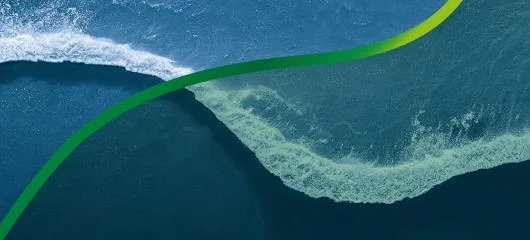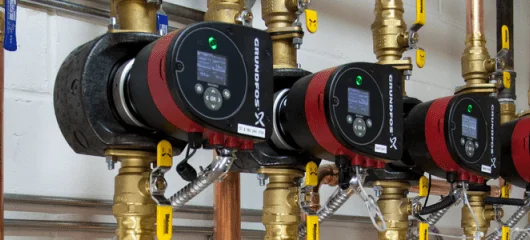Are they the same thing? What's different?
Really a tank is a tank. Anytime we use a tank for storage of hot or cold water it could be a buffer, storage or both. We usually think of a buffer tank as one that stores thermal mass (sort of like a "flywheel") so a heating or cooling source doesn't cycle too much when smaller loads are turning on and off. We would use the term "storage tank" for a project that is generating chilled water during the nighttime when electricity is cheap, then drawing off the cold storage during the day to provide HVAC cooling.
Of course the tank you choose must be built and listed for the application temperature and pressure and must have the correct safety relief valves. Choose a well-insulated tank. Also, large pipe connections are important to minimize pressure drop, especially for two-pipe connection applications. A four-pipe tank also provides the added benefit of hydraulic separation for systems that have primary/secondary pumps.
Caleffi ThermoCon and SolarCon tanks are built exactly for these and many other storage/buffer applications. They are well-insulated and have plenty of large, easy-to-use ports. Check out our NAS200 Series, and contact us with any questions!
Bob "Hot Rod" Rohr







Also an electric immersion element could be added to the tank to give you an additional energy source, perhaps to take advantage of off-peak rates. Many manufacturers offer UL listed elements and control options.
I've always liked this photo sent in on Caleffi Excellence showing a Caleffi buffer tank in a Combi GEO Heat Pump/Boiler system.
In reply to I've always liked this photo by Mark Olson
Mark, is the supply from the heat pump piped into the upper port of the buffer tank, and the supply to the zones leaving the other upper port? That's my assumption but I can't tell for sure from the photo.
In reply to Mark, is the supply from the by Bob Deering
You are correct, yes. The thermal stratification is maintained for best performance. Check out page 7 of our idronics issue #17 "Thermal Storage in Hydronic Systems".
I'd like to add a 500 gallon tank to the open side of a OWB system connected to a greenhouse and was wondering you had any suggested piping arrangements.
Thanks,
Kelly
In reply to I'd like to add a 500 gallon by Kelly Burnham
Kelly,
I would highly suggest looking through our Idronics journals for some inspiration.
https://www.caleffi.com/usa/en-us/technical-magazine
Specifically issue #10 (HYDRONICS FOR WOOD-FIRED HEAT SOURCES) and issue #17 (THERMAL STORAGE IN HYDRONIC SYSTEMS).
Best Regards,
Cody Mack
Applications Engineer
Caleffi North America
In reply to Kelly, by Cody Mack
Hey Cody,
Iv;e been reading thru the Stratification section of issue #17. I'll be re-thinking my tank pipe connection strategy. It's opposite to what you'd think.
Thanks,
Kelly
In reply to I'd like to add a 500 gallon by Kelly Burnham
Sure, you can add a buffer, if you pipe it in series, it just becomes an addition to the OWB capacity. keep in mind it will see O2 and rust away if it is a plain steel vessel. Add O2 scavenger chemicals from time to time available from the OWF dealers. Is the distribution a pressurized loop? If so you need a heat exchanger in the mix, shown on page 20, for example.
https://www.caleffi.com/sites/default/files/file/idronics_10.pdf
If you pipe it in series, it just becomes an extension of the OWB tank. keep in mind any steel vessel will be subject to corrosion on an open system. Add O2 scavenger chemicals form OWF dealers.
If the distribution side is pressurized, you will need a heat exchanger in the piping, page 20 here
https://www.caleffi.com/sites/default/files/file/idronics_10.pdf
In reply to If you pipe it in series, it by Bob Rohr
Hey Bob,
Thanks for your comments. We are using 500 gal horizontal propane tank and Yes, there are (2) Brazed plate heat exchangers between the OWB and the load loops (3). It would appear that the recommended orientation of the tank is Vertical, where this is not possible/practial in this installation. The tank will be horizontal so the inlet will be at one end at low level and the outlet at the opposite end at high level. Given that propane tanks are pressure rated for 200+ psi and the closed loop is operating at 10 to 12 psi it should be acceptable to pipe the tank into the (closed) load loop, where corrosion would be mitigated - which is a good idea.
Question: Given that the intended use of the tank is to provide thermal storage for the greenhouse, would it make sense then to pipe the tank in series with the loop that serves the greenhouse? All the loops are connected via common header so the thermal storage would serve all loads indirectly, e.g. house, garage, shop, etc.
Thanks,
Kelly